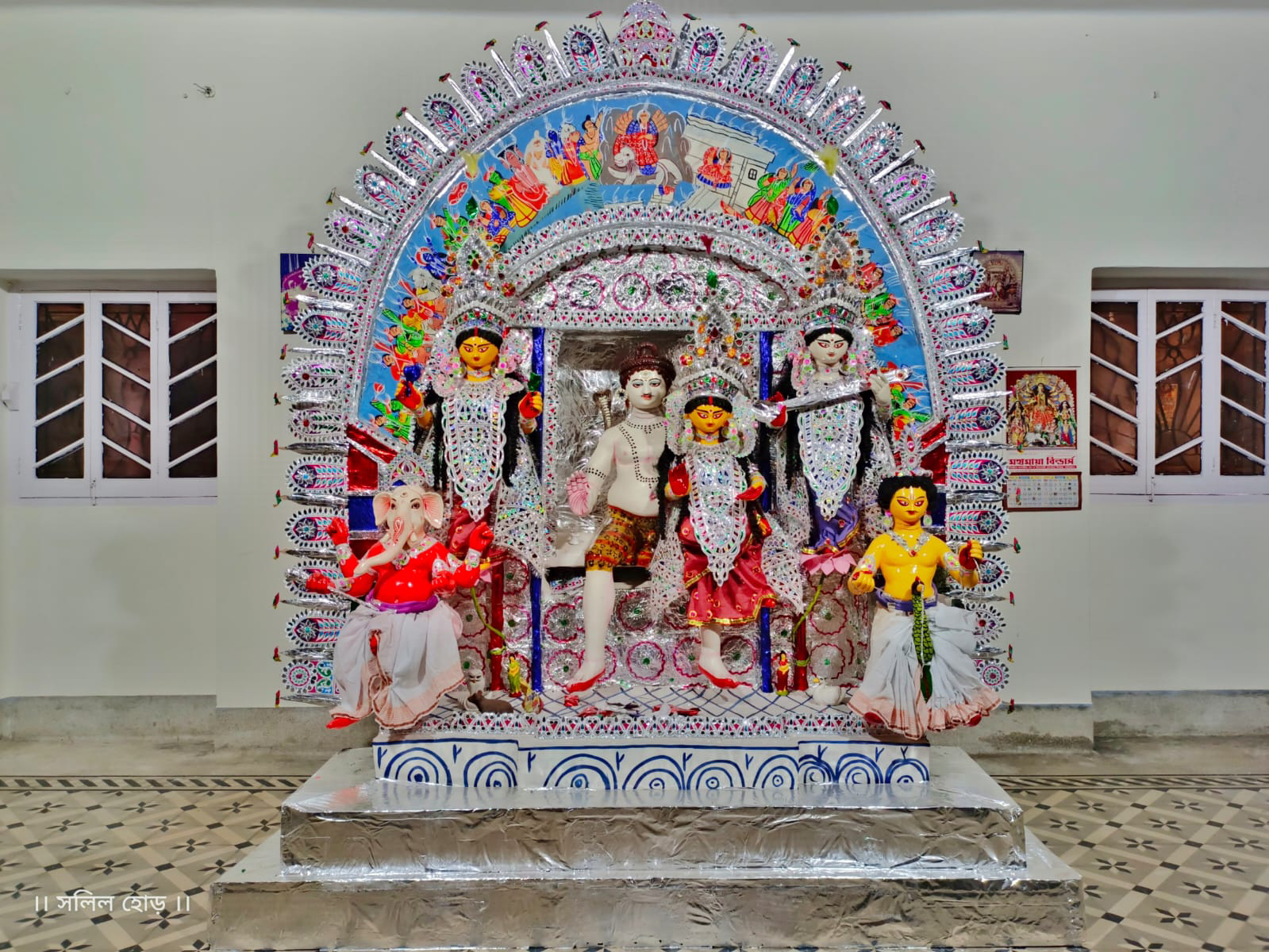বাবু সুবল চাঁদ চন্দ্র বাড়ির দুর্গাপুজো, বেচু চ্যাটার্জি স্ট্রিট (Baboo Subol Chand Chunder House's Durgapuja, Bechu Chatterjee Street)
সমগ্র কলকাতা জুড়ে অনেক বনেদি বাড়ির দুর্গাপুজো আমরা দেখতে যাই, তাদের সাবেকিয়ানা দেখে মুগ্ধ হই। এই সব পুজোগুলোর মধ্যে আমার একদম ব্যতিক্রমী লেগেছে, উত্তর কলকাতার বেচু চ্যাটার্জি স্ট্রীটে অবস্থিত বাবু সুবল চাঁদ চন্দ্র দের ঠাকুরবাড়ির দুর্গাপুজো। চন্দ্র পরিবারের দুর্গা প্রতিমা, বাংলা জুড়ে পূজা করা বাকি মূর্তিগুলির থেকে একেবারেই আলাদা। এটি পরিবারের বৈষ্ণব শিকড়ের সাথে সামঞ্জস্যপূর্ণ, যেখানে দেবীর শিব-দুর্গা রূপের পূজা করা হয়। এখানে, দেবী দুর্গাকে শিবের কোলে বসে থাকতে দেখা যায়। দেবী এখানে অভয়া রূপে বিরাজমান হন, যা শান্তি ও সম্প্রীতির প্রতীক।
এবার এই পুজোর ইতিহাস একটু জেনে নেওয়া যাক। পূজোর সূত্রপাত করেছিলেন চন্দ্র পরিবারের পূর্বপুরুষ শ্রী রাম প্রসাদ চন্দ্র। ১৭৬১ খ্রিস্টাব্দে উত্তর কলকাতার জোড়াসাঁকো অঞ্চলে চন্দ্র পরিবারের দুর্গাপুজো শুরু হয়। উনবিংশ শতকের শেষের দিকে এই পরিবারের উত্তরপুরুষ বিশিষ্ট শিল্পপতি বাবু সুবল চাঁদ চন্দ্র, পুজোটিকে ঝামাপুকুর অঞ্চলের একটি বাড়িতে নিয়ে আসেন। বাবু সুবল চাঁদ চন্দ্রর মূল ব্যবসা ছিল কাপড় এবং পাটের। ম্যানচেস্টার এবং বার্মিংহামে তার কাপড়ের মিল ছিল। তিনি ছিলেন বেঙ্গল চেম্বার অফ কমার্স অ্যান্ড ইন্ডাস্ট্রিজের একজন প্রতিষ্ঠাতা-সদস্য এবং ব্রিটিশ ইন্ডিয়ান অ্যাসোসিয়েশনের একজন বিশিষ্ট সদস্য। সামাজিক ক্ষেত্রে বিভিন্ন দাতব্য কার্যক্রম, দরিদ্র ও অভাবীদের জন্য ছাত্র হোস্টেল পরিচালনা এবং পদাবলি কীর্তনের পৃষ্ঠপোষকতার ক্ষেত্রে তার অনেক অবদান ছিল। স্বয়ং ঈশ্বরচন্দ্র বিদ্যাসাগর ছিলেন তার ঘনিষ্ঠজনদের মধ্যে অন্যতম। কথিত আছে, ঈশ্বরচন্দ্র বিদ্যাসাগর তার সময়ে এসে দেবী দুর্গার পূজা করতেন।
এবার আসি এই পরিবারের পুজোর রীতিনীতির বিষয়ে। এখানে পুজোর সময় পশু বলি নিষিদ্ধ। অষ্টমীতে এখানে পরিবারের মহিলারা ধুনো-পোড়ানোর অনুষ্ঠানে অংশগ্রহণ করেন। এই অনুষ্ঠানে উপোস রেখে, তিনটি মাটির থালা নিয়ে বসে (মাথায় এবং দুই পায়ে) সেখানে আগুন জ্বালানো হয়। এছাড়াও সন্ধিপূজার সময় ১০৮টি মাটির প্রদীপ, কলা পাতার সরু স্ট্রিপের ক্রসক্রস করা প্যাটার্নের উপর খুব সুন্দর করে সাজিয়ে জ্বালানো হয়, যেটা চমৎকার দেখতে লাগে! নবমী তিথিতে একটি সংকল্পের পরে অর্থের প্রতীকী বণ্টন করা হয়, যাকে "দক্ষিনান্ত" বলা হয়। নীলকণ্ঠ পাখির ব্যবহার নিষিদ্ধ হওয়ার আগে পর্যন্ত, দশমীতে এই বাড়িতে নীলকণ্ঠ পাখি ওড়ানোর একটি প্রথা ছিল।
আজ অবধি পরিবারের সদস্যরা, শতাব্দীপ্রাচীন ঐতিহ্য এবং রীতিনীতিগুলি যতটা সম্ভব পালন করার চেষ্টা করেন। পুজোর দিনগুলোতে পরিবারের পুরুষেরা পরেন চেলি, ঐতিহ্যবাহী রেশমি ধুতি এবং চাদর; নারীরা গয়না হিসেবে পরেন নথ এবং মাওল। দেবীকে যে ভোগ নিবেদন করা হয়, সেখানেও রয়েছে বৈচিত্র্য। ভোগ তৈরির সময় কোনোপ্রকার লবণ ব্যবহার করা হয় না, এবং চিনির শিরায় ডুবানো কোনো মিষ্টিও দেবীর উদ্দেশ্যে নৈবেদ্য হিসেবে ব্যবহার করা হয় না। দশমীতে বিসর্জনের পরে প্রায় সব বনেদি বাড়িতে যে সিঁদুর খেলা হয়, সেটাও এখানে নিষিদ্ধ।
তথ্য সহায়তা: চন্দ্র পরিবার
**********************************
A Unique Durga Puja: Tradition and Devotion at the Chandra Family's Thakurbari
Among the many ancestral homes across Kolkata that open their doors for Durga Puja, offering glimpses into rich traditions, the Durga Puja at the Thakurbari of Babu Subal Chand Chandra on Bechu Chatterjee Street in North Kolkata stands out as truly exceptional. The idol of Goddess Durga worshipped by the Chandra family is distinctly different from most other Durga idols found throughout Bengal. This unique representation is deeply rooted in the family's Vaishnava heritage, where the deity is revered in her Shiva-Durga form. Here, Goddess Durga is depicted seated on the lap of Lord Shiva. In this form, the Goddess embodies the "Abhaya" mudra, symbolizing fearlessness, peace, and harmony.
Delving into the history of this puja, its origins can be traced back to the Chandra family's ancestor, Shri Ram Prasad Chandra, who initiated the Durga Puja in 1761 in the Jorabagan area of North Kolkata. In the late 19th century, Babu Subal Chand Chandra, a prominent industrialist and a descendant of the family, moved the puja to its current location in Jhamapukur, situated on Bechu Chatterjee Street. Babu Subal Chand Chandra was a successful businessman primarily involved in the textile and jute industries, owning mills in Manchester and Birmingham. He was a founding member of the Bengal Chamber of Commerce and Industry and a distinguished member of the British Indian Association. His contributions extended to various social initiatives, including charitable activities, managing student hostels for the poor and needy, and patronizing Padavali Kirtan (a form of devotional music). Notably, Ishwar Chandra Vidyasagar, the renowned social reformer and scholar, was among his close associates. It is said that Ishwar Chandra Vidyasagar himself participated in the Durga Puja at the Thakurbari during his time.
The rituals observed during this puja are also distinctive. Animal sacrifice is strictly prohibited. On the day of Ashtami, the women of the family participate in the "Dhuno Porano" ceremony. This ritual involves fasting and balancing three earthen plates filled with burning coconut husk (dhuno) on their heads and feet, a remarkable display of devotion. Furthermore, during the Sandhi Puja, 108 earthen lamps are beautifully arranged and lit on a crisscross pattern of banana leaf strips, creating a mesmerizing spectacle. On the Navami tithi, following a sankalpa (a vow or resolution), a symbolic distribution of wealth takes place, known as "Dakshinanta." In earlier times, before the prohibition of using Neelkanth birds, there was a tradition of releasing a Neelkanth bird on Dashami.
To this day, the family members strive to uphold the centuries-old traditions and rituals as much as possible. During the puja days, the men of the family wear "cheli," a traditional silk dhoti, and a chaddar (shawl), while the women adorn themselves with "nath" (nose ring) and "mawol" (a type of traditional jewelry). The bhog (offerings of food) presented to the Goddess is also prepared with specific considerations. No salt is used in the preparation of the bhog, and sweets dipped in sugar syrup are not offered to the deity. The custom of Sindoor Khela (smearing of vermilion) after the immersion on Dashami, a common practice in many ancestral homes, is also prohibited here.
Information courtesy: The Chandra Family.






Comments
Post a Comment